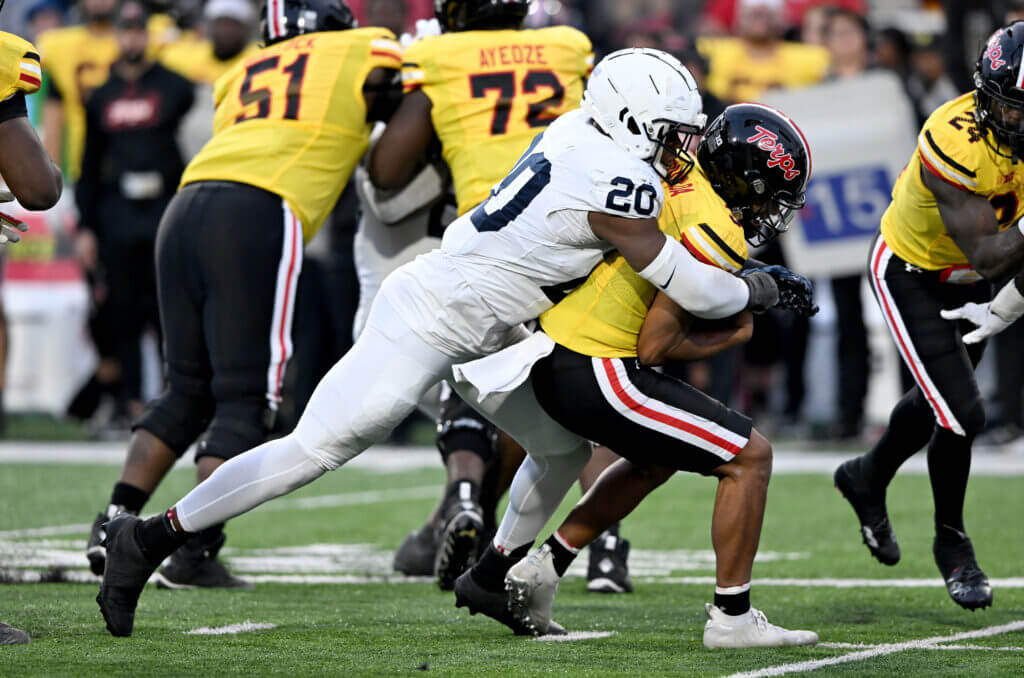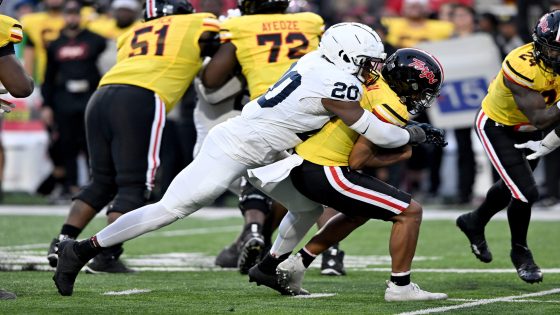
General manager Eric DeCosta will remind you every chance he gets this time of year that the Baltimore Ravens are a best-player-available drafting team. They won’t chase needs or overreact to draft runs.
To hear DeCosta tell it late Friday night, they haven’t had to over the past two days. Things have just fallen in the Ravens’ favor to allow them to achieve their goals.
“So far, we’ve gotten pretty lucky,” DeCosta said with a smile.
Any list of Ravens needs heading into the draft had these items near the top: a starting-caliber boundary cornerback, a plug-and-play starting right tackle and a rotational edge rusher. A big-play wide receiver and a starting guard would have also been included, but with only three picks in the top 100, the Ravens’ decision-makers were always going to be limited in what they were going to be able to achieve.
The Ravens checked off the first one late Thursday night, when they selected Clemson cornerback Nate Wiggins at No. 30, getting ahead of the run on corners that took place in the second round.
“Chop called me while I was on this interview, I’ll have to call him back” @A1Isaac1 😂😂 pic.twitter.com/VvwiJ1mMRj
— Baltimore Ravens (@Ravens) April 27, 2024
In Friday’s second round, the Ravens got the offensive tackle that they coveted, taking Washington’s Roger Rosengarten at pick No. 62 and starting a run on offensive linemen that extended into the middle of the third round. Rosengarten, who protected the blind side of left-handed quarterback Michael Penix Jr. the past two years, didn’t allow a sack in that span.
One round later with the second of their two Day 2 picks, the Ravens found their edge rusher, taking Penn State’s Adisa Isaac at pick No. 93 of the third round. Isaac had 7 1/2 sacks and 16 tackles for loss in his final season in Happy Valley.
The Ravens have more work to do, and they have six selections on Saturday’s Day 3 to do it. They still need a running back to play behind Derrick Henry and Justice Hill, and their wide receiver depth chart is still thin and lacking in diversity. They still could add another competitor for their two open starting guard jobs. Defensively, depth at inside linebacker and safety feels like a necessity.
But DeCosta and the Ravens clearly had three major priorities early in this draft and they’ve answered them, paving the way for Day 3, when they won’t feel pressured to do anything beyond taking the highest-ranked player on the board when they are on the clock.
“When your need and best player kind of match up, then you really have something special, and I think that’s happened a couple times for us,” DeCosta said. “So, it’s good. I think tomorrow, we’re in a position where we’re just basically an open highway, and we can just sit back and just draft the best guys that we see on the board, without any real thought to position or how they’re going to fit roster-wise. We’re just going to draft the best football players.”
The jury is obviously still out on how the new Ravens will perform at the next level, but DeCosta is pleased with the thought process and decision-making that led to their selections.
In Wiggins’ case, the Ravens were tempted by several offers to trade back and out of No. 30, the proposed deals set to land them significant draft capital. DeCosta, however, balked. He worried about missing out on an opportunity to grab a starting-caliber corner. He then watched early Friday as six corners were selected from pick No. 40 to pick No. 61.
“We feel fortunate,” DeCosta said. “We saw those corners go at the beginning today — all of the guys we liked got picked.”
Then, there was the Rosengarten decision. The Ravens identified him as a player of significant interest back at the Senior Bowl. They met with him at the NFL Scouting Combine in March, and Ravens coach John Harbaugh cut the allotted 17-minute interview off at 10 minutes. Harbaugh and offensive line coach Joe D’Alessandris had heard what they needed to hear.
“He was on point, he knew his technique, he knew his assignments, he was very self-aware with the things he needed to get better at, and he just seemed like a motivated guy,” Harbaugh said. “He seemed like a Raven.”
The Ravens wanted a right tackle who could come in and compete with Daniel Faalele and potentially veteran Josh Jones for the starting job that opened when the team traded Morgan Moses to the Jets in March. There were several tackles they were interested in on Day 1, but just about all of them were long gone by pick 30.
Before the draft resumed Friday evening, DeCosta and Harbaugh had earmarked Rosengarten as the guy they wanted at No. 62. They just weren’t sure if he’d be there. Ravens manager of data and decision science Derrick Yam told DeCosta earlier Friday that there was an 80 percent chance that Rosengarten would still be available at 93. DeCosta said that seemed a little high and Yam grudgingly agreed.
The Ravens pondered a trade-up scenario in the second round but opted to stay put. They then fielded an offer from the Kansas City Chiefs, who wanted to move from 64 to 62. DeCosta considered it and then balked, concerned that the Chiefs were going to select Rosengarten. The Chiefs wound up trading with the San Francisco 49ers to get to 63 and did pick a tackle, BYU’s Kingsley Suamataia.
Baltimore’s selection of Rosengarten started a stretch where 12 offensive linemen were selected from pick 62 to pick 86.
“We’ve never seen anything like what we saw today, where every single guard and tackle on the front board got picked in a span of 20 picks,” DeCosta said. “That was kind of surprising.”
Rosengarten was just happy that he was at the start of it and Baltimore was the team that selected him.
“As soon as I heard Baltimore, that’s the first thing that came to my mind — blocking for Lamar (Jackson),” Rosengarten said. “An elite-level quarterback, an MVP-level quarterback. It’s a dream come true. Baltimore is one of those places where it’s been a historic program for such a long time, and just to hear my name called and have everybody on the staff come and congratulate me, it was such a great feeling.”
The process of selecting Isaac was far simpler. Some draft pundits had him as an early-to-mid-second-round pick. Dane Brugler, The Athletic’s draft analyst, ranked Isaac as the seventh-best outside linebacker. Five of the six players ahead of him were selected in Thursday’s first round.
Baltimore wanted to come out of Day 2 with a pass rusher and waited patiently as the run on offensive linemen in the late second and early third round allowed an outside linebacker whom they liked to drop into their laps at pick No. 93.
Isaac, who is 6 feet 4 and 253 pounds, is a high-energy player who relies on his size, speed and explosiveness.
“I saw a guy on tape that makes a lot of plays, and he does it in a real athletic way,” Harbaugh said of Isaac. “He’s a very athletic guy. Very explosive starter, can cover ground, he can get to the edge of a tackle and beat them on the edge with quickness or beat them underneath with quickness, and then, long-arm power, he’s got that, too. He’s got some real pass-rush ability. He’s heavy-handed against the run. So for us, he’s going to be in the rotation.”
(Photo of Adisa Isaac: G Fiume / Getty Images)



